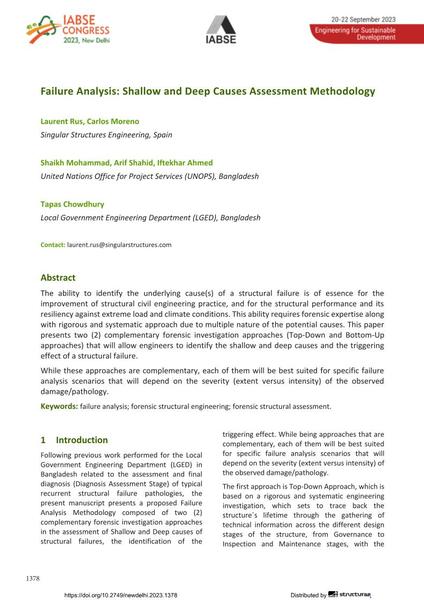Failure Analysis: Shallow and Deep Causes Assessment Methodology

|
|
|||||||||||
Bibliografische Angaben
| Autor(en): |
Laurent Rus
(Singular Structures Engineering, Spain)
Carlos Moreno (Singular Structures Engineering, Spain) Shaikh Mohammad Arif Shahid (United Nations Office for Project Services {UNOPS}, Bangladesh) Arif Shahid (United Nations Office for Project Services {UNOPS}, Bangladesh) Iftekhar Ahmed (United Nations Office for Project Services {UNOPS}, Bangladesh) Tapas Chowdhury (Local Government Engineering Department {LGED}, Bangladesh) |
||||
|---|---|---|---|---|---|
| Medium: | Tagungsbeitrag | ||||
| Sprache(n): | Englisch | ||||
| Tagung: | IABSE Congress: Engineering for Sustainable Development, New Delhi, India, 20-22 September 2023 | ||||
| Veröffentlicht in: | IABSE Congress New Delhi 2023 | ||||
|
|||||
| Seite(n): | 1378-1385 | ||||
| Anzahl der Seiten (im PDF): | 8 | ||||
| DOI: | 10.2749/newdelhi.2023.1378 | ||||
| Abstrakt: |
The ability to identify the underlying cause(s) of a structural failure is of essence for the improvement of structural civil engineering practice, and for the structural performance and its resiliency against extreme load and climate conditions. This ability requires forensic expertise along with rigorous and systematic approach due to multiple nature of the potential causes. This paper presents two (2) complementary forensic investigation approaches (Top-Down and Bottom-Up approaches) that will allow engineers to identify the shallow and deep causes and the triggering effect of a structural failure. While these approaches are complementary, each of them will be best suited for specific failure analysis scenarios that will depend on the severity (extent versus intensity) of the observed damage/pathology. |
||||
| Stichwörter: |
Schadensanalyse
|
||||
